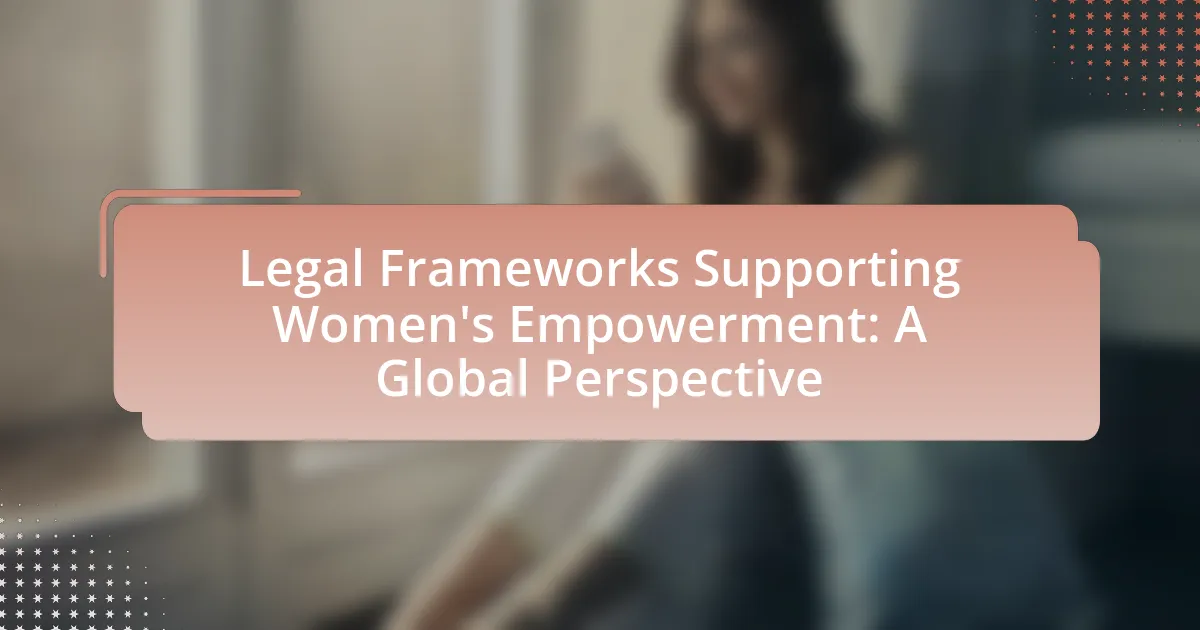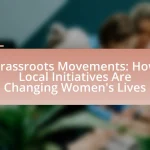The article focuses on legal frameworks supporting women’s empowerment globally, highlighting international treaties, national laws, and regional agreements that promote gender equality and women’s rights. It examines the variations in these frameworks across different regions, the role of key treaties like CEDAW, and the challenges faced in implementing effective legal protections. Additionally, the article discusses the impact of cultural norms on legal enforcement, common gaps in legislation, and best practices for strengthening legal frameworks. It emphasizes the importance of education, advocacy, and collaboration between governments and NGOs in enhancing women’s rights and empowerment.
What are the Legal Frameworks Supporting Women’s Empowerment Globally?
Legal frameworks supporting women’s empowerment globally include international treaties, national laws, and regional agreements. Key international treaties such as the Convention on the Elimination of All Forms of Discrimination Against Women (CEDAW) establish legal standards for women’s rights and promote gender equality. National laws in various countries, like the Gender Equality Act in Sweden, provide specific protections and promote equal opportunities in areas such as employment and education. Additionally, regional agreements, such as the African Charter on Human and Peoples’ Rights, emphasize women’s rights within the context of regional development. These frameworks collectively aim to eliminate discrimination and empower women across different societies.
How do these legal frameworks vary across different regions?
Legal frameworks supporting women’s empowerment vary significantly across different regions due to cultural, economic, and political factors. For instance, in Nordic countries, comprehensive gender equality laws and policies promote women’s rights in various sectors, resulting in high levels of female participation in the workforce and politics. In contrast, many regions in the Middle East and North Africa face legal restrictions that limit women’s rights, such as guardianship laws that require women to obtain permission from male relatives for various activities. Additionally, Sub-Saharan Africa exhibits a mix of progressive and restrictive laws, where some countries have enacted strong legal protections for women, while others still grapple with traditional practices that undermine women’s rights. These variations highlight the influence of local contexts on the effectiveness and implementation of legal frameworks aimed at empowering women.
What are the key international treaties promoting women’s rights?
The key international treaties promoting women’s rights include the Convention on the Elimination of All Forms of Discrimination Against Women (CEDAW), adopted by the United Nations in 1979, which establishes a comprehensive framework for women’s rights and gender equality. Additionally, the Beijing Declaration and Platform for Action, adopted in 1995, outlines strategic objectives for advancing women’s empowerment and gender equality globally. The Convention on the Rights of the Child (CRC), adopted in 1989, also emphasizes the rights of girls and the importance of gender equality in childhood. These treaties collectively serve as foundational legal instruments that guide nations in implementing policies and practices to promote and protect women’s rights.
How do national laws reflect or contradict international standards?
National laws can reflect international standards by incorporating principles from treaties and conventions, such as the Convention on the Elimination of All Forms of Discrimination Against Women (CEDAW), into domestic legislation. For instance, countries that ratify CEDAW are expected to align their laws with its provisions, promoting gender equality and women’s rights. Conversely, national laws may contradict international standards when they maintain discriminatory practices or fail to implement protections outlined in international agreements. An example is when a country has laws that restrict women’s rights to inheritance or property ownership, which directly opposes CEDAW’s mandate for equality. This divergence highlights the gap between international commitments and local legal practices, affecting the overall empowerment of women.
Why is a legal framework essential for women’s empowerment?
A legal framework is essential for women’s empowerment because it establishes rights and protections that enable women to participate fully in society. Such frameworks provide legal recognition of women’s rights, ensuring access to education, healthcare, and employment opportunities. For instance, the Convention on the Elimination of All Forms of Discrimination Against Women (CEDAW) has been ratified by 189 countries, promoting gender equality and empowering women through legal means. This legal backing not only protects women from discrimination and violence but also facilitates their economic independence and political participation, which are critical for achieving gender equality.
What role do laws play in protecting women’s rights?
Laws play a crucial role in protecting women’s rights by establishing legal frameworks that prohibit discrimination and promote gender equality. These laws, such as the Convention on the Elimination of All Forms of Discrimination Against Women (CEDAW), provide a binding international standard that countries must adhere to, ensuring that women’s rights are recognized and enforced. For instance, in many countries, laws against domestic violence and sexual harassment have been enacted to safeguard women’s safety and autonomy, reflecting a commitment to uphold their rights. Additionally, legal provisions for equal pay and employment opportunities further empower women economically, contributing to their overall empowerment and societal participation.
How can legal frameworks influence societal attitudes towards women?
Legal frameworks can significantly influence societal attitudes towards women by establishing rights and protections that promote gender equality. For instance, laws that criminalize domestic violence and sexual harassment not only provide legal recourse for victims but also signal to society that such behaviors are unacceptable. Research indicates that countries with strong legal protections for women, such as the implementation of the Convention on the Elimination of All Forms of Discrimination Against Women (CEDAW), often experience shifts in public perception, leading to greater acceptance of women’s rights and roles in society. Additionally, legal frameworks that support equal pay and employment opportunities contribute to changing attitudes by normalizing women’s participation in the workforce, thereby challenging traditional gender roles.
What are the Challenges in Implementing Legal Frameworks for Women’s Empowerment?
The challenges in implementing legal frameworks for women’s empowerment include inadequate enforcement mechanisms, cultural resistance, and lack of awareness among women about their rights. In many countries, laws exist on paper but are not effectively enforced due to insufficient resources or political will, leading to a gap between legislation and actual practice. Cultural resistance often manifests in societal norms that prioritize traditional gender roles, hindering women’s access to legal protections. Furthermore, many women remain unaware of their rights and the legal frameworks designed to protect them, which limits their ability to seek justice or empowerment. These factors collectively undermine the effectiveness of legal frameworks aimed at promoting women’s empowerment.
What barriers exist in enforcing these legal frameworks?
Barriers in enforcing legal frameworks supporting women’s empowerment include inadequate implementation, lack of resources, cultural resistance, and insufficient awareness among affected populations. In many countries, laws exist on paper but are not effectively enforced due to limited funding and personnel dedicated to monitoring compliance. For instance, a report by UN Women highlights that only 40% of countries have laws that protect women from violence, and even fewer have mechanisms to enforce these laws. Cultural norms often perpetuate gender discrimination, leading to resistance against legal reforms. Additionally, many women remain unaware of their rights under these frameworks, which hinders their ability to seek justice or support.
How do cultural norms impact the effectiveness of legal protections?
Cultural norms significantly impact the effectiveness of legal protections by shaping societal attitudes towards laws and their enforcement. For instance, in societies where patriarchal norms prevail, legal protections for women may be undermined by cultural beliefs that prioritize male authority, leading to inadequate enforcement of laws against domestic violence. Research by the World Bank indicates that in countries with strong gender norms, women are less likely to report violence due to fear of stigma or retaliation, thus diminishing the legal system’s ability to protect them effectively. Additionally, cultural acceptance of harmful practices, such as child marriage, can result in legal frameworks being ignored or inadequately implemented, further illustrating how cultural norms can obstruct the intended outcomes of legal protections.
What are the common gaps in legislation regarding women’s rights?
Common gaps in legislation regarding women’s rights include insufficient legal protections against gender-based violence, lack of equal pay provisions, and inadequate maternity and parental leave policies. For instance, many countries do not have comprehensive laws addressing domestic violence, leaving women vulnerable to abuse without legal recourse. Additionally, the gender pay gap persists in numerous jurisdictions, with women earning significantly less than men for the same work; according to the World Economic Forum, the global gender pay gap is projected to take over 135 years to close. Furthermore, maternity leave policies often do not provide adequate support, with only 45% of countries offering paid maternity leave, which can hinder women’s participation in the workforce. These gaps highlight the need for stronger legislative frameworks to ensure women’s rights are fully protected and promoted.
How can these challenges be addressed?
To address the challenges in legal frameworks supporting women’s empowerment, governments must implement comprehensive policies that promote gender equality and enforce existing laws. For instance, countries can enhance legal protections against gender-based violence and discrimination by adopting international treaties such as the Convention on the Elimination of All Forms of Discrimination Against Women (CEDAW). Evidence shows that nations with strong legal frameworks and enforcement mechanisms experience lower rates of violence against women and higher levels of female participation in the workforce. Additionally, increasing access to legal resources and education for women can empower them to assert their rights effectively, as demonstrated by programs in countries like Rwanda, where legal literacy initiatives have significantly improved women’s legal awareness and participation in governance.
What strategies have proven effective in overcoming legal barriers?
Effective strategies for overcoming legal barriers include advocacy for legislative reform, building coalitions among stakeholders, and utilizing legal aid services. Advocacy for legislative reform has been shown to change discriminatory laws, as seen in countries like Rwanda, where women gained significant representation in government through constitutional changes. Building coalitions among stakeholders, such as NGOs, community leaders, and legal experts, enhances the collective voice for change, exemplified by the successful campaigns for women’s rights in various regions. Additionally, utilizing legal aid services empowers women to navigate the legal system, evidenced by programs in India that provide free legal assistance, resulting in increased access to justice for marginalized women.
How can advocacy and civil society contribute to legal reforms?
Advocacy and civil society can significantly contribute to legal reforms by mobilizing public opinion, influencing policymakers, and providing expertise on legal issues. For instance, organizations like the Women’s Legal Defense Fund have successfully lobbied for changes in laws related to gender equality, demonstrating the impact of organized advocacy efforts. Furthermore, civil society groups often conduct research and disseminate information that highlights the need for legal reforms, such as the 2019 report by UN Women, which emphasizes the importance of legal frameworks in promoting women’s rights. This combination of public engagement, expert knowledge, and strategic lobbying creates a powerful mechanism for driving legal change.
What are the Best Practices for Strengthening Legal Frameworks Supporting Women’s Empowerment?
Best practices for strengthening legal frameworks supporting women’s empowerment include enacting comprehensive anti-discrimination laws, ensuring equal access to education and healthcare, and implementing policies that promote women’s participation in political and economic decision-making. Countries like Rwanda, which has the highest percentage of women in parliament globally at 61%, demonstrate the effectiveness of legal quotas and supportive policies in enhancing women’s representation. Additionally, integrating gender-sensitive approaches in legal reforms, such as the Convention on the Elimination of All Forms of Discrimination Against Women (CEDAW), provides a robust framework for accountability and progress. These practices collectively create an environment that fosters gender equality and empowers women across various sectors.
How can countries improve their legal frameworks for women’s rights?
Countries can improve their legal frameworks for women’s rights by enacting comprehensive legislation that addresses gender-based violence, discrimination, and economic inequality. For instance, implementing laws that specifically criminalize domestic violence and sexual harassment can provide better protection for women. According to the World Health Organization, approximately 1 in 3 women globally experience physical or sexual violence, highlighting the urgent need for such legal protections. Additionally, countries can enhance women’s rights by ensuring equal access to education and employment opportunities through affirmative action policies. The United Nations reports that increasing women’s participation in the workforce can boost economic growth by up to 27% in some regions. By aligning national laws with international human rights standards, such as the Convention on the Elimination of All Forms of Discrimination Against Women, countries can create a more equitable legal environment that supports women’s empowerment.
What role does education play in enhancing awareness of women’s rights?
Education plays a crucial role in enhancing awareness of women’s rights by providing individuals with knowledge about legal frameworks, social norms, and gender equality. Through education, people learn about their rights and the importance of gender equity, which empowers them to advocate for themselves and others. For instance, studies show that educated women are more likely to participate in political processes and community decision-making, leading to increased advocacy for women’s rights. According to the United Nations Educational, Scientific and Cultural Organization (UNESCO), girls’ education significantly correlates with improved gender equality outcomes, as educated women tend to have fewer children, better health, and increased economic opportunities. This evidence underscores the transformative impact of education on awareness and advocacy for women’s rights.
How can collaboration between governments and NGOs enhance legal protections?
Collaboration between governments and NGOs can enhance legal protections by combining resources, expertise, and advocacy efforts to create more comprehensive legal frameworks. For instance, NGOs often have grassroots knowledge and can identify specific legal gaps affecting vulnerable populations, while governments can implement policies and enforce laws. A notable example is the partnership between the United Nations and various NGOs in promoting the Convention on the Elimination of All Forms of Discrimination Against Women (CEDAW), which has led to improved legal protections for women in multiple countries. This collaboration results in stronger advocacy for legal reforms, increased awareness of rights, and better implementation of existing laws, ultimately leading to enhanced legal protections for marginalized groups.
What practical steps can individuals take to support women’s empowerment through legal means?
Individuals can support women’s empowerment through legal means by advocating for and participating in the creation and enforcement of laws that promote gender equality. This includes lobbying for legislation that protects women’s rights, such as equal pay laws, anti-discrimination laws, and laws against gender-based violence. For instance, the implementation of the Equal Pay Act in various countries has been a significant step toward closing the gender wage gap, which, according to the World Economic Forum, could take over 135 years to close at the current rate. Additionally, individuals can support organizations that provide legal assistance to women facing discrimination or violence, thereby ensuring that women have access to justice. Engaging in community education about women’s rights and legal protections can also empower women to assert their rights effectively.
How can community engagement foster a culture of legal awareness and advocacy?
Community engagement can foster a culture of legal awareness and advocacy by actively involving individuals in discussions and activities related to their legal rights and responsibilities. This involvement enhances understanding of legal frameworks, particularly those supporting women’s empowerment, by providing accessible information and resources tailored to community needs. For instance, initiatives such as legal workshops, community forums, and partnerships with local organizations have been shown to increase awareness of laws and rights, leading to greater advocacy efforts. Research indicates that communities with higher levels of engagement in legal education programs experience a 30% increase in participation in advocacy activities, demonstrating the effectiveness of such engagement in promoting legal awareness.
What resources are available for individuals seeking to understand women’s rights laws?
Individuals seeking to understand women’s rights laws can access a variety of resources, including legal databases, government websites, and non-governmental organizations (NGOs) focused on women’s rights. Legal databases such as Westlaw and LexisNexis provide comprehensive access to case law, statutes, and legal commentary on women’s rights issues. Government websites, like those of the United Nations and national human rights commissions, offer official documents, reports, and guidelines related to women’s rights laws. Additionally, NGOs such as the Women’s Legal Defense Fund and the Center for Women’s Global Leadership publish research, toolkits, and advocacy materials that clarify women’s rights legislation and its implications. These resources collectively provide a solid foundation for understanding the legal frameworks that support women’s empowerment globally.


